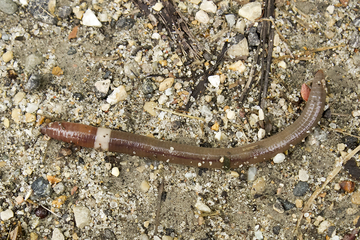
06/25/2019
Naturalists and gardeners in Central New York may come across a surprise this summer as they’re tending to their plants or hiking through the woods.
A twitchy, jumping surprise.
Jumping worms, an invasive group of earthworms originally from Asia, have been spotted in the area. These worms are expected to become widespread throughout New York state and around the world. They grow to high densities in the top layer of the soil and consume leaf litter and soil organic matter, changing conditions for plants and other soil-dwelling organisms.
There is growing concern among land managers about the spread and impacts of jumping worms as well as the limited knowledge about their biology. The group comprises several earthworm species, which are difficult to identify using external characteristics. In order to prevent their invasion and minimize their impacts, scientists must understand how these species move and how humans play a role in their dispersal across the landscape.
Andrea Dávalos and Laura Eierman, both assistant professors in SUNY Cortland’s Biological Sciences Department, and their colleague, Annise Dobson, a postdoctoral researcher at Yale University, will assess the distribution and spread of jumping worms through a $95,000 grant from the New York State Department of Environmental Conservation.
SUNY Cortland’s Undergraduate Research Council has also contributed to the project through funding for a work-study student in the project.
“It’s a bridge between research and management,” Dávalos said. “It’s really coming from land practitioners and land managers. We do have that multidisciplinary approach and that’s where all of these heads come together. We’ll be able to put all of our different strengths into one project.”
Over the next three years, and in conjunction with New York State’s Office of Parks, Recreation and Historic Preservation, these researchers will construct detailed maps of worm distribution within Taughannock Falls State Park in Trumansburg, N.Y. and use genetic analysis to understand differences and similarities between populations.
The researchers will team with Friends of Recreation, Conservation and Environmental Stewardship (FORCES), a volunteer program that pairs students, faculty and New York State Parks staff with members of local communities to offer hands-on academic experiences and increase environmental stewardship in state parks. Together with SUNY Cortland students and FORCES stewards, researchers will collect earthworm and soil samples from the park and use genetic tools to characterize the various jumping worm species. The experience will provide an opportunity for students to participate in multidisciplinary research and engage with professionals in the field.
Researchers hope that the study will allow scientists, state parks staff and the public to better understand the jumping worm invasion and lead to additional management solutions as well. The best current management approach is to avoid moving earthworms to earthworm-free areas. This effort will help parks staff ensure that their management and restoration efforts are not moving jumping worms to regions that are currently uninvaded.
This research will be used to generate best management guidelines for park patrons and staff and will be implemented throughout the state. The researchers ultimately aim to respond to the land managers need and to better protect state resources.